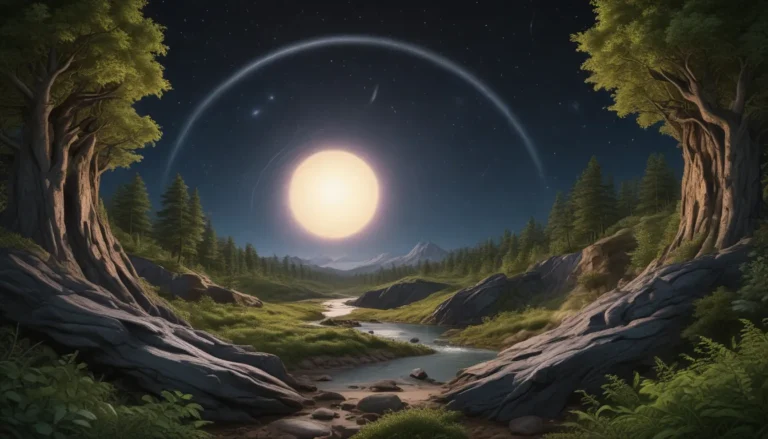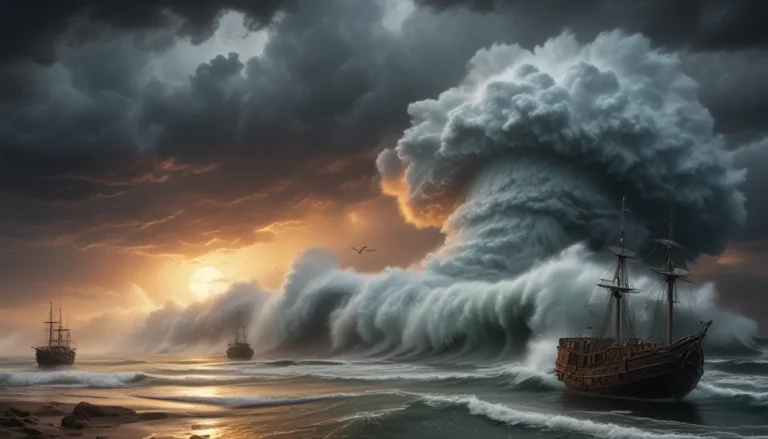A Note About Images: The images used in our articles are for illustration purposes only and may not exactly match the content. They are meant to engage readers, but the text should be relied upon for accurate information.
Welcome to the fascinating world of natural hazards, where the forces of nature shape our planet and often leave us in awe of their power. From earthquakes that can strike anywhere to hurricanes with different names around the globe, natural hazards are a reminder of the incredible diversity and complexity of our world. In this article, we will delve into 19 intriguing facts about natural hazards that will not only educate you but also spark your curiosity about these awe-inspiring events.
Journey through Natural Hazards
Natural hazards like earthquakes and hurricanes serve as a powerful reminder of the immense power of nature and the need for preparedness for unexpected events. Understanding and preparing for natural hazards, such as floods and wildfires, is crucial for our safety and well-being as they can have significant impacts on communities worldwide. Let’s embark on a journey through the world of natural hazards and uncover some of the most intriguing facts about these awe-inspiring phenomena.
Earthquakes: Tremors of the Earth
Earthquakes are not limited by geographical boundaries and can occur on any continent or in any country. These seismic events, with their little warning, remind us of the constant shifting and movement of our planet, shaping landscapes and impacting communities. The largest earthquake ever recorded, with a magnitude of 9.5, struck the coast of Chile in 1960, causing tsunamis that reached as far as Hawaii, Japan, and the Philippines.
Hurricanes, Cyclones, and Typhoons
While commonly known as hurricanes, these powerful tropical cyclones are called by different names in various parts of the world. In the Indian Ocean, they are referred to as cyclones, while in the Western Pacific, they are known as typhoons. These natural phenomena exhibit the sheer force of nature, showcasing the diversity of their names as they unleash their power across oceans.
Unleashing the Power of Nature
The United States experiences over 1,000 tornadoes each year, making it the most tornado-prone country in the world. This unique phenomenon is a result of a combination of geography, weather patterns, and atmospheric conditions, creating the perfect storm for these destructive whirlwinds. Lightning strikes the Earth around 100 times per second, with each strike showcasing the buildup and discharge of electrical energy within storm clouds.
Environmental Impact of Volcanoes
Volcanoes, with their explosive eruptions, can trigger climate change by releasing ash and gases into the atmosphere. The eruption of Mount Pinatubo in 1991 led to a drop in global temperatures by about 1 degree Fahrenheit, demonstrating the significant impact of volcanic activity on our planet’s climate. Floods, the most common natural disaster, affect more people worldwide than any other type of hazard, causing extensive property damage and loss of life.
Thriving Ecosystems after Wildfires
While wildfires may seem devastating in the short term, they play a crucial role in renewing ecosystems and maintaining biodiversity. These intense fires clear out vegetation, allowing for the regeneration of new plant life and creating habitat opportunities for various species. Similarly, avalanches are more likely to occur on slopes with inclines of 30 to 45 degrees, where the accumulation of snow can reach critical points, leading to dangerous flows of debris down mountainsides.
Deadly Heatwaves and Destructive Landslides
Heatwaves can have severe health implications, with extreme temperatures leading to heatstroke, dehydration, and even death in regions like the Middle East and northern Africa. Landslides, triggered by heavy rainfall or seismic activity, can cause significant damage to infrastructure and pose a threat to human life, highlighting the destructive potential of these natural events. Sinkholes, formed when underground water erodes bedrock, can appear suddenly, swallowing up buildings and vehicles in their path.
Perils of Dust Storms and Lightning Strikes
Dust storms, also known as haboobs, lift large quantities of dust and sand into the air, traveling thousands of miles across continents. These massive clouds of dust can affect visibility and air quality in regions far from their origin. Contrary to popular belief, lightning can strike the same place twice, especially during intense thunderstorms or in areas prone to frequent lightning activity. Tsunamis, triggered by undersea earthquakes or volcanic eruptions, can travel at incredible speeds, up to 600 miles per hour, causing widespread destruction along coastal areas.
Secondary Hazards of Earthquakes and Climate Change
Earthquakes can trigger a cascade of secondary hazards, including landslides, tsunamis, and volcanic eruptions, significantly changing the Earth’s crust and setting off natural disasters. The impacts of climate change, such as rising temperatures and altered weather patterns, can intensify the frequency and intensity of natural hazards, posing challenges for communities worldwide. Understanding and preparing for these phenomena are essential for our safety and well-being, as we navigate the complex and interconnected nature of our world.
Exploring Natural Hazards: A Reminder of Nature’s Power
Natural hazards are a fascinating and often unpredictable aspect of our planet, shaping landscapes and impacting communities in profound ways. By studying and understanding these events, we can better prepare ourselves for their occurrence and minimize the damage they cause. These 19 intriguing facts about natural hazards provide a glimpse into the sheer power and complexity of these phenomena, urging us to continue researching and learning to develop effective strategies for prevention, response, and recovery.
Conclusion: Embracing the Wonders of Nature
Natural hazards captivate us with their awe-inspiring forces, reminding us of the ever-changing and dynamic nature of our planet. From earthquakes and hurricanes to droughts and wildfires, these phenomena are a testament to the power and unpredictability of nature. By exploring these facts and delving into the science behind natural hazards, we deepen our appreciation for the incredible phenomena that shape our world.
FAQs: Answering Your Curiosities
-
What are natural hazards?
Natural hazards are natural events or phenomena that have the potential to cause harm to people, property, or the environment, including earthquakes, floods, hurricanes, wildfires, and more. -
Can natural hazards be prevented?
While it is challenging to prevent natural hazards entirely, measures can be taken to minimize their impact, such as early warning systems, infrastructure resilience, and land-use planning strategies. -
Is climate change linked to an increase in natural hazards?
Scientists suggest that climate change can influence the frequency and intensity of some natural hazards, contributing to more severe storms and events. -
How can we prepare for natural hazards?
Preparing for natural hazards involves creating emergency plans, assembling disaster supply kits, securing important documents, and staying informed about potential hazards in your area. -
Are all regions equally prone to natural hazards?
No, vulnerability to natural hazards varies by region, with some areas being more susceptible to specific hazards due to geographical, weather, or human factors. -
Are natural hazards predictable?
While some hazards can be predicted to some extent, others are more challenging to foresee accurately, with scientists constantly working to improve forecasting capabilities. -
Do natural hazards impact everyone equally?
No, the impacts of natural hazards can vary depending on factors like preparedness, infrastructure, and socioeconomic conditions, highlighting the importance of awareness and preparedness.
As we continue to explore the wonders and complexities of natural hazards, let us deepen our understanding and appreciation for the forces that shape our planet. By educating ourselves and preparing for these events, we can navigate the unpredictable yet awe-inspiring nature of natural hazards with resilience and readiness.






